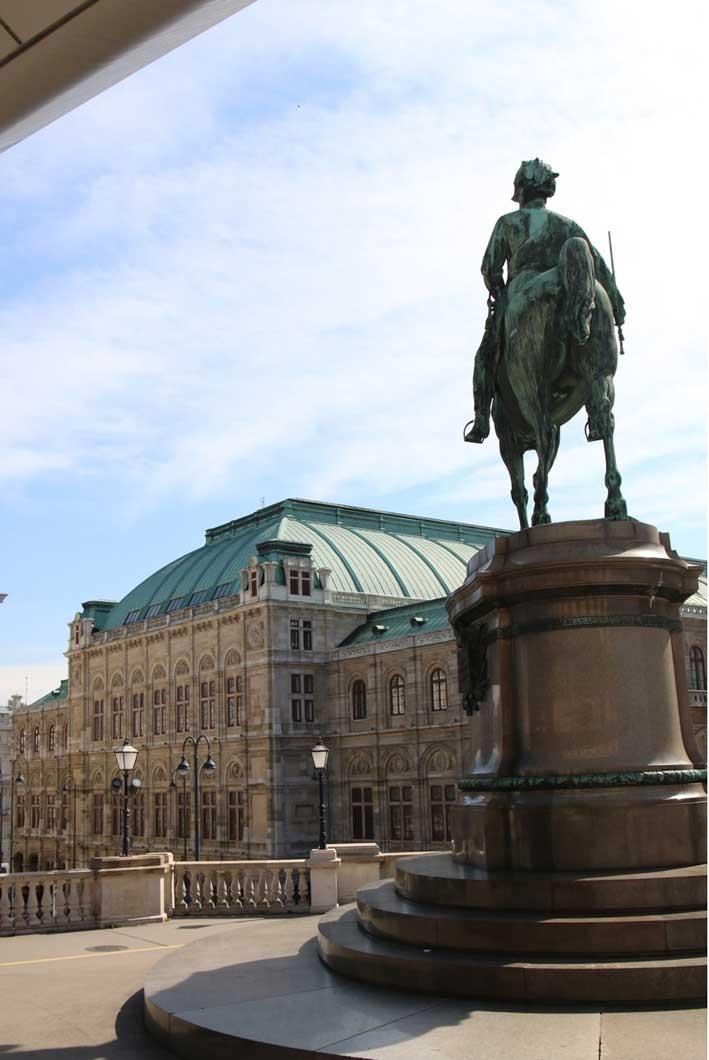In Vienna, standing in front of the Austrian parliament, I thought about history - it is an excellent place to. Out of the street it stands on, the wily hands of time have conspired to change the world. Completed in 1883, the Austrian parliament was modelled on Greek buildings from the Athenian Acropolis, effectively establishing a connection with a line of great civilisations and the ideal of democracy.
Not being aware of these things won't impede you from enjoying the city; Vienna is a staggering medley of beautiful architecture, museums and cathedrals, streets and parks; countless things to see, do and explore, as well as restaurants, cafes and places to leisure about. Vienna is European heartland and I found it to be gorgeous. Admittedly, I am a very casual tourist, I plan nothing other than museums and set out to explore on foot to look for them, allowing myself an erratic route and time to explore anything interesting I encounter.

Although Vienna is a big city, the main attractions are built around the Inner Stadt, notably the Ringstrasse, built to replace the old city walls in the 1850s. It was a project that embraced city progress and along this street were built some of the most impressive modern edifices of the day. Today this street is a great monument to the cultural and political affluence of 19th century Vienna.
My hotel was behind Rathausplatz, the Viennese city hall, a magnificent Neo-gothic edifice of spectacular proportions, with a big park in front of it looking like its porch, on the Ringstrasse. Walking about the neighbourhood, and knowing certain information about the city I was trying to piece together the bits and pieces, and soon acquainted myself.
And here I was walking along the Ringstrasse. The Parliament stood to the left of the Rathausplatz, opposite the Burgtheater, a statue-rich theatre from 1888, whose staircases were painted by Gustav Klimt. Next to this is the Heldenplatz, Hero Square, the imperial square that is overlooked magisterially by part of the Hofburg Palace, with its imposing facade and equally imposing horseback statue of Archduke Charles keeping vigil.

Across the Ringstrasse from Heldenplatz are two identical buildings, the imperial museums: the Kunsthistoriches and the Naturhistoriches Museums, Art History and Natural History Museums. They are symmetrical, opposite each other across Maria-Theresien Square (Marie-Antoinette) and standing as showcases of national wealth. The Kunsthistoriches was the first museum I planned to visit - on the inside, a tremendously eye-dazzling place: marble and gold, laid out in intricate Rococo style filling the interior, along with beautifully painted ceilings and arches, some, again, by
Gustave Klimt. The collection of art inside is astounding - one of the world's best and biggest painting collection, as well as sculpture, artefacts, armoury, devotional reliquaries, paraphernalia and other odd bits and pieces of ivory carving, gold and precious gems - literally dazzling.

Beyond Maria-Theresian Platz is the Museums' Quartier, a big complex that houses the Leopold Museum, my next destination, as well as Mumok, Kunsthalle Wien, Architektur Centrum Wien and ZoomKindmuseum, along with a number of eateries and cafes and leisure areas. It is generally a great place to hang out and potentially spend a day or two exploring all of the Quarter.
The Leopold Museum is home to over 5,000 works of modern Austrian art - Egon Schiele, Gustave Klimt, Oskar Kokoschka and Richard Gerstl. Apart from personally being a big fan of Schiele's work, this collection is phenomenal and a true Austrian national treasure.
Back to walking along the Ringstrasse, one encounters an opera house, the world-famous Wiener Staatsoper, where major productions are put up. But I was looking for the Albertina, just up the road to the left of Staatsoper. The Albertina is an art museum whose collection focuses mostly on prints. They have an astounding one million old master prints, as well as about 65,000 drawings, along with other collections of impressionist and modern art. Famously the museum owns the prints and drawings of Da Vinci, Dürer, Bruegel the Elder, Fragonard, Monet and other giants from art.
For the last museum destination I decided to get a taxi, more for issues of time than anything (I walked it back to the hotel, and it was quite a nice walk). The Belvedere is the most beautiful place you'll visit in Vienna. Having been the summer residence of the Habsburgs, the palace sits on a hill overlooking Vienna, hence Belvedere - with its extensive grounds, it makes for a lovely stroll. Although it has been engulfed in the growing city, it used to be on the outskirts with virgin land all around it. Inside, the museum houses a collection that presents an almost complete overview of Austrian art and thus an insight into Austrian history, from Medieval to Baroque to Modernist works of art.
I wrapped up most of my days with a restaurant visit at Café Français on Roosevelt Platz, following a suggestion by a friend - it does have amazing food. A special restaurant I tried was Do&Co on Stephenplatz, up high over the square, level with the magnificent cathedral. Having tried the famous Austrian schnitzel (pounded meat made very thin, coated with bread crumbs and fried) at a kiosk, I decided to try it at this five-star restaurant, much to my delight. Other Viennese treats include the infamous (but much-loved) hot dog stand outside the Albertina Museum and the mouth-watering Sachertorte of which you can only have enough when you pass out. I tried it at the hotel opened by the man whose father invented the Sachertorte, the Hotel Sacher Café.
The food is reason enough to re-visit Vienna, let alone the myriad of museums and constant bombarding of opulence and grandiose architecture.